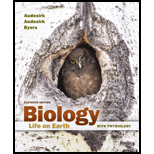
Biology: Life on Earth with Physiology (11th Edition)
11th Edition
ISBN: 9780133923001
Author: Gerald Audesirk, Teresa Audesirk, Bruce E. Byers
Publisher: PEARSON
expand_more
expand_more
format_list_bulleted
Concept explainers
Question
Chapter 44.2, Problem 2CYL
Summary Introduction
To describe:
Primary and secondary growth in plants.
Introduction:
Plants have two types of cells: meristem cells, and differentiated cells. Meristem cells are undifferentiated cells which have an infinite capacity to multiply and give rise to other cells. Differentiated cells are specialized cells these cells have specialized structure and perform a particular function. The meristem is of two types: apical meristem, and lateral meristem. Apical meristem is present on the tips of roots and shoots. And lateral meristem is present in roots, stem, and even in branches.
Expert Solution & Answer
Want to see the full answer?
Check out a sample textbook solution
Students have asked these similar questions
Can I get a handwritten answer please. I'm having a hard time understanding this process. Thanks
Say you get AATTGGCAATTGGCAATTGGCAATTGGCAATTGGCAATTGGCAATTGGC 3ʹ and it is cleaved with Mspl restriction enzyme - how do I find how many fragments?
What is amplification bias?
Chapter 44 Solutions
Biology: Life on Earth with Physiology (11th Edition)
Ch. 44.1 - Prob. 1CYLCh. 44.1 - distinguish between monocots and dicots?Ch. 44.2 - Prob. 1HYEWCh. 44.2 - explain the difference between meristem cells and...Ch. 44.2 - Prob. 2CYLCh. 44.3 - Prob. 1CYLCh. 44.3 - Prob. 2CYLCh. 44.3 - Prob. 3CYLCh. 44.4 - Prob. 1CSCCh. 44.4 - Prob. 1TC
Ch. 44.4 - diagram an argosperm leaf and describe the...Ch. 44.4 - describe some specialized leaf adaptations and...Ch. 44.5 - Prob. 1TCCh. 44.5 - Prob. 1CYLCh. 44.5 - Prob. 2CYLCh. 44.5 - Prob. 3CYLCh. 44.6 - Prob. 1CYLCh. 44.6 - Prob. 2CYLCh. 44.7 - Prob. 1CYLCh. 44.7 - Prob. 2CYLCh. 44.7 - Prob. 3CYLCh. 44.7 - Prob. 4CYLCh. 44.7 - Prob. 1CSCCh. 44.8 - Prob. 1TCCh. 44.8 - Prob. 2TCCh. 44.8 - Prob. 1CYLCh. 44.8 - Prob. 2CYLCh. 44.8 - Prob. 3CYLCh. 44.9 - Prob. 1TCCh. 44.9 - Prob. 1CYLCh. 44.9 - Prob. 1CSRCh. 44 - Taproots a. are characteristic of dicots. b. act...Ch. 44 - Prob. 2MCCh. 44 - Bark a. is a type of epidermal tissue. b. includes...Ch. 44 - Prob. 4MCCh. 44 - Prob. 5MCCh. 44 - Prob. 1FIBCh. 44 - Prob. 2FIBCh. 44 - Prob. 3FIBCh. 44 - Prob. 4FIBCh. 44 - Prob. 5FIBCh. 44 - Prob. 1RQCh. 44 - Prob. 2RQCh. 44 - Prob. 3RQCh. 44 - Prob. 4RQCh. 44 - Prob. 5RQCh. 44 - Prob. 6RQCh. 44 - Prob. 7RQCh. 44 - Prob. 8RQCh. 44 - Prob. 9RQCh. 44 - Prob. 10RQCh. 44 - Describe how water and minerals are absorbed by a...Ch. 44 - Prob. 12RQCh. 44 - Prob. 13RQCh. 44 - Prob. 14RQCh. 44 - Prob. 1ACCh. 44 - Prob. 2ACCh. 44 - Prob. 3AC
Knowledge Booster
Learn more about
Need a deep-dive on the concept behind this application? Look no further. Learn more about this topic, biology and related others by exploring similar questions and additional content below.Similar questions
- What would happen if transcriptome analysis were done on liver and muscle cells?arrow_forwardBiology How many grams of sucrose would you add to 100mL of water to make a 100 mL of 5% (w/v) sucrosesolution?arrow_forwardWhich marker does this DNA 5ʹ AATTGGCAATTGGCAATTGGCAATTGGCAATTGGCAATTGGCAATTGGC 3ʹ show?arrow_forward
- The Z value of LOD for two genes is 4, what does it mean for linkage and inheritance?arrow_forwardBiology How will you make a 50-ul reaction mixture with 2uM primer DNA using 10 uM primer DNA stocksolution and water?arrow_forwardBiology You’re going to make 1% (w/v) agarose gel in 0.5XTBE buffer 100 ml. How much agarose are you goingto add to 100 ml of buffer? The volume of agaroseis negligible.arrow_forward
- Biology How will you make a 50-ul reaction mixture with0.2 mM dNTP using 2-mM dNTP stock solution andwater?arrow_forwardBiology What is 200 pmole/uL in Molar concentration?arrow_forwardBiology How will you make a 50-ul reaction mixture with 1Xreaction buffer in it using water and 5X buffer stocksolution?arrow_forward
- Biology How would you make 200 uL of 10 pmole/uLprimer DNA solution using the 200 pmole/uLprimer DNA stock solution and distilled water?arrow_forwardBiology Now you have the 5 M of NaCl stock solution. Howwould you make one liter of 100 mM NaCl solutionusing the 5 M of NaCl solution and distilled water?arrow_forwardDevelopmental Biology Lab Question How to make one liter of 5 M NaCl stock solution?The molar weight of NaCl is 58.44 g/mol.(Molecular weight is 58.44 Dalton or amu).arrow_forward
arrow_back_ios
SEE MORE QUESTIONS
arrow_forward_ios
Recommended textbooks for you
 Biology 2eBiologyISBN:9781947172517Author:Matthew Douglas, Jung Choi, Mary Ann ClarkPublisher:OpenStax
Biology 2eBiologyISBN:9781947172517Author:Matthew Douglas, Jung Choi, Mary Ann ClarkPublisher:OpenStax Biology (MindTap Course List)BiologyISBN:9781337392938Author:Eldra Solomon, Charles Martin, Diana W. Martin, Linda R. BergPublisher:Cengage Learning
Biology (MindTap Course List)BiologyISBN:9781337392938Author:Eldra Solomon, Charles Martin, Diana W. Martin, Linda R. BergPublisher:Cengage Learning- Health Safety And Nutrition F/Young ChildHealth & NutritionISBN:9781305144767Author:MAROTZPublisher:Cengage
 Biology: The Dynamic Science (MindTap Course List)BiologyISBN:9781305389892Author:Peter J. Russell, Paul E. Hertz, Beverly McMillanPublisher:Cengage Learning
Biology: The Dynamic Science (MindTap Course List)BiologyISBN:9781305389892Author:Peter J. Russell, Paul E. Hertz, Beverly McMillanPublisher:Cengage Learning

Biology 2e
Biology
ISBN:9781947172517
Author:Matthew Douglas, Jung Choi, Mary Ann Clark
Publisher:OpenStax


Biology (MindTap Course List)
Biology
ISBN:9781337392938
Author:Eldra Solomon, Charles Martin, Diana W. Martin, Linda R. Berg
Publisher:Cengage Learning

Health Safety And Nutrition F/Young Child
Health & Nutrition
ISBN:9781305144767
Author:MAROTZ
Publisher:Cengage

Biology: The Dynamic Science (MindTap Course List)
Biology
ISBN:9781305389892
Author:Peter J. Russell, Paul E. Hertz, Beverly McMillan
Publisher:Cengage Learning
